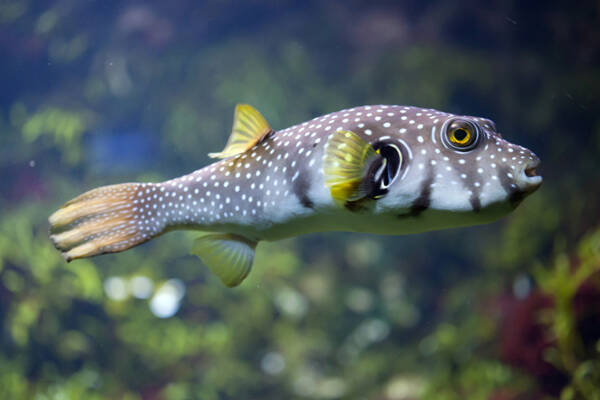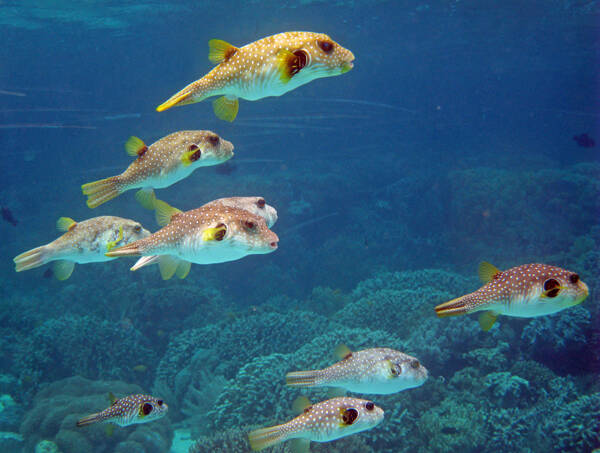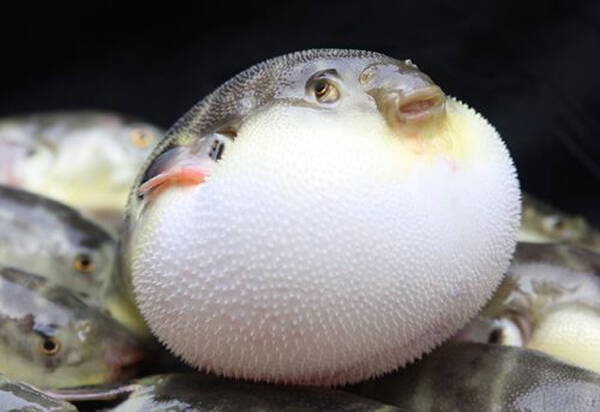Pufferfish (scientific name Tetraodontidae) is also known as pufferfish or puffers in foreign languages. Because of its "pig-like" appearance and its frequent activities in river estuaries, it is commonly known as pufferfish in Jiangsu and Zhejiang, while it is called Dingba in Shandong, Latou in Hebei, Guaiyu or Jibao in Guangdong, and Guiyu in Guangxi.

A few pufferfish species migrate upstream to rivers to spawn during the reproductive season. For example, the dark-striped Oriental can migrate upstream along the Yangtze River to Dongting Lake to spawn, or it can settle in the Yangtze River and lakes connected to the river. It is an important fish resource in my country and mainly lives in the middle or bottom layers of the water. It is a bottom-dwelling fish with the habit of migrating between rivers and seas. Pufferfish have a varied diet, mainly shellfish, crustaceans and young fish.
Tetrodotoxin (TTX) is a highly toxic marine bioactive substance, making it an important toxic factor in seafood poisoning incidents. Poisoning incidents caused by tetrodotoxin are mainly caused by accidentally eating poisonous pufferfish, which often occur in China, Japan and some Southeast Asian countries.
Domestic and foreign scholars have conducted a series of studies on the source of tetrodotoxin and found that tetrodotoxin is not only present in pufferfish, but also widely distributed in other animals, such as nemerteans, salamanders, tree frogs, short-headed toads and other amphibians that also secrete toxins on their bodies. At the same time, it was found that many bacteria can also produce TTX, but there are both exogenous and endogenous theories, and no conclusion can be drawn. There are many studies on the chemical properties, pharmacological and toxicological effects of pufferfish toxin. With the deepening of research, the safety of eating wild pufferfish will be further enhanced, and pufferfish toxin will have broad application prospects in the medical field.
The amount of toxin in pufferfish varies in different parts. Generally speaking, the ovary contains the most, followed by the liver, and the blood, eyes, gills, and skin all contain a little, and the muscle does not contain TTX. However, after the fish dies, the toxins in the internal organs can penetrate into the muscles, and at this time the muscles also contain a small amount of TTX. The toxicity of different types of pufferfish varies. For example, fish of the genus Oriental pufferfish in the family Pufferfish are generally highly toxic, while fish of the family Pufferfish and the family Boxfish are generally not toxic. The same type of pufferfish lives in different seas, and its toxicity after being caught is significantly different. The toxicity of pufferfish varies with the season, especially during the spawning period (December to June of the following year), when it is very toxic. Generally speaking, wild pufferfish are more toxic than farmed pufferfish.
The most studied theory of the origin of pufferfish toxin is the pufferfish. It is generally believed that the possibilities of pufferfish producing pufferfish toxin in the seawater environment are: ① The pufferfish itself produces TTX in the seawater environment after going to the sea; ② Some organisms in the seawater contain TTX, which is absorbed and stored in the body after being swallowed by pufferfish; ③ TTX in the metabolites of many organisms in the ocean. From the current research, it is unlikely that pufferfish itself produces pufferfish toxin, because in addition to pufferfish, there are many organisms in the ocean that pufferfish like to eat that contain TTX. In addition, TTX cannot be detected in pufferfish that live in freshwater and have not migrated to the sea, which also shows that pufferfish do not produce toxins themselves, but after feeding them with TTX-containing feed for a period of time, TTX can be detected in their bodies. Therefore, it is very likely that TTX accumulates in the pufferfish through the food chain, and many toxic bacteria in the ocean adhere to the organisms that pufferfish like to eat. After entering the pufferfish's body, they form a mutually beneficial symbiotic relationship with it. The pufferfish can release TTX through the exposure of skin glands, thereby playing a role in resisting natural enemies.

The symptoms of pufferfish poisoning depend on the person's constitution and the amount of TTX ingested. Generally, the first symptoms of poisoning are paralysis of the lips and tongue, followed by paralysis of the motor nerves, then dilation of the peripheral blood vessels, a drop in blood pressure, and difficulty breathing. Finally, as consciousness slowly disappears, the respiratory center is completely paralyzed until death. Death usually occurs within 4 to 6 hours after onset. If the person is still alive after more than 8 hours, he or she can generally recover. This is mainly because TTX is detoxified and excreted quickly in the body. There is no specific drug for pufferfish poisoning, and pufferfish poisoning develops quickly and has a high mortality rate. Treatment should focus on early vomiting, gastric lavage, and excretion.
There are many types of pufferfish in my country, and there are as many as 16 types of oriental fish distributed in the Yellow Sea, Bohai Sea and East China Sea. The varieties with higher economic value include: red fin oriental, false clear oriental, dark pattern oriental, bow spot oriental, chrysanthemum yellow oriental, lead spot oriental, leopard pattern oriental, yellow fin oriental, insect pattern oriental, etc. Among them, red fin oriental and false clear oriental are the best-selling in the international market. In my country, the dark-striped oriental pufferfish, which has the habit of spawning upstream, is the most popular among the people and the most expensive, with a price of up to 1,000 yuan/kg to 3,000 yuan/kg.

Pufferfish has high nutritional, edible and medical value. The meat of puffer fish is delicious, tender and boneless, with a protein content of up to 28.2%. Its nutritional value is richer than other fish. It has long been famous as a precious fish. As early as more than 2,000 years ago, my country regarded puffer fish as a delicacy. There is a saying among the people that "If you don't eat puffer fish, how can you know the taste of fish? If you eat puffer fish, all tastes are gone" and "Eat puffer fish at the risk of death". The ancient poet Su Dongpo loved to eat puffer fish and said that puffer fish was "worth dying for". Mei Yu also praised it, saying "Spring islands grow reed buds, spring banks fly poplar flowers, puffer fish at this time, more expensive than fish and shrimp". With the improvement of people's material life, the rational use of puffer fish resources has received more and more attention, the research on puffer fish detoxification technology has been improved, and the non-toxic breeding technology of puffer fish has become more mature. More and more consumers hope to taste safe and harmless delicacies, and the market potential is huge. However, puffer fish resources are limited. If they are not reasonably used and protected, puffer fish resources will eventually be exhausted one day.
The most poisonous fish: All pufferfish (Tetraodontidae) contain the neurotoxin TTX. Although the potency of the neurotoxin varies between different pufferfish species, 16 mg of any one is enough to kill a 70 kg person; if injected, 2 mg is not needed. When threatened, pufferfish will puff up their bodies and erect their spines to defend against attackers. (Guinness World Records)
Protect wildlife and eliminate game.
Maintaining ecological balance is everyone's responsibility!